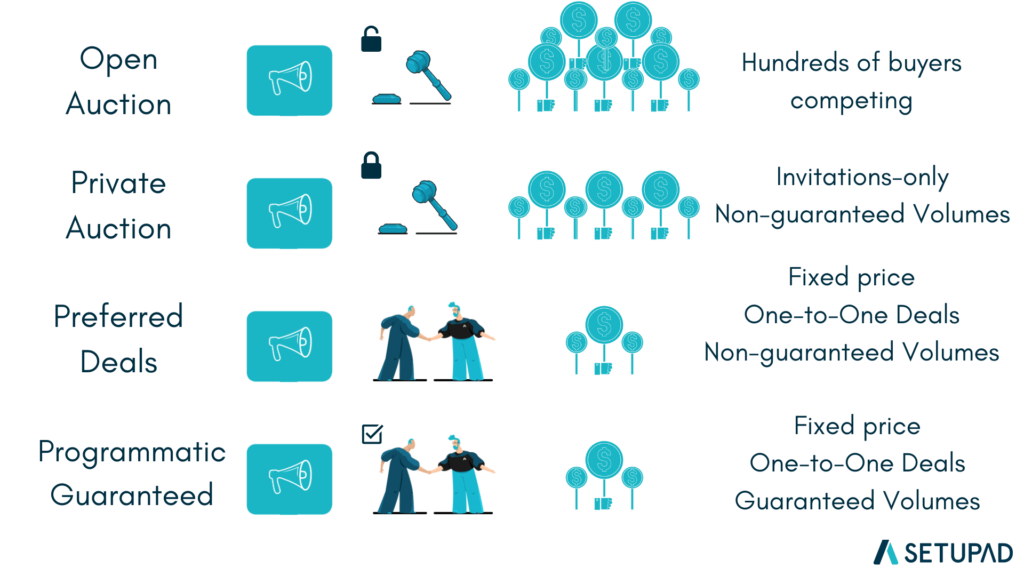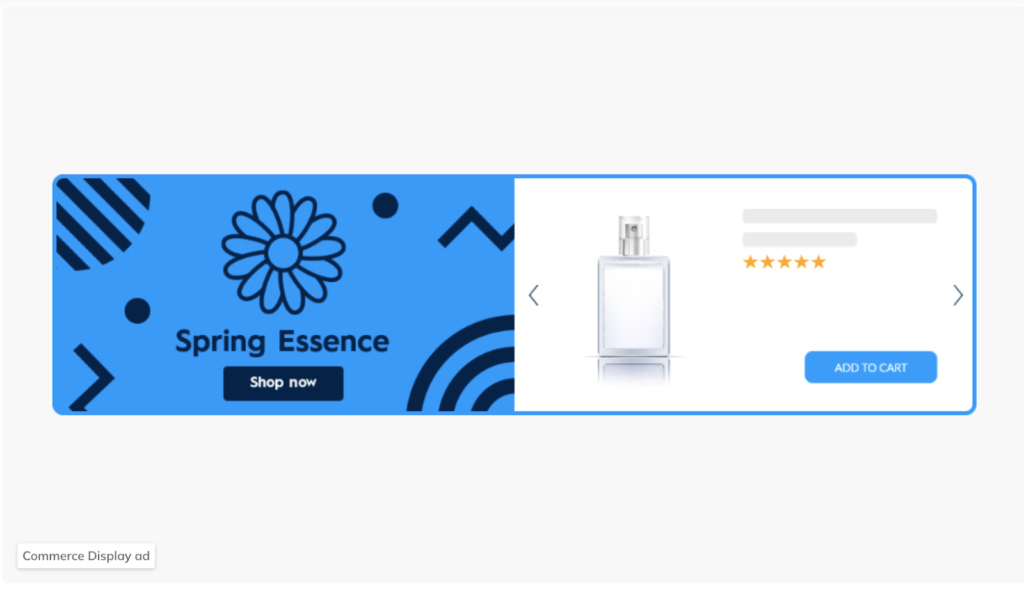4 Types of Programmatic Deals: A Comprehensive Guide
Each publisher’s ad inventory is unique, and there are different ways of selling it–through open and private auctions, preferred deals, and programmatic guaranteed deals.
Today, we will guide you through the 4 types of programmatic deals and explain how they differ.
What is Programmatic Advertising – Short Introduction
Programmatic advertising uses automated technology and algorithms to buy and sell digital advertising space. This approach streamlines purchasing ad space by removing the need for manual negotiations and paperwork.
Instead, programmatic advertising uses data-driven insights to target the right audience at the right time, which can result in more efficient and effective campaigns. With the rise of digital media and data availability, programmatic advertising has become popular for many advertisers and publishers.
Programmatic deals we’ll discuss below often go under the term Programmatic Direct. If you want the benefits of both traditional reservations and programmatic buying, you may want to consider one or more programmatic direct deals.
Open Auction vs. Private Auction vs. Preferred Deals vs. Programmatic Guaranteed
Transaction Costs For Different Programmatic Deals*
In the programmatic ecosystem, advertisers buy ads through adtech platforms. Each ad buying and selling platform retains a portion of ad spend. Publishers keep the remaining ad spend after all fees have been deducted.
| Tech fee on the seller side | Tech fee on seller side | |
| Open Auction | ±10-20% | ±10-30% |
| Private Auction | ±10% | ±10-20% |
| Preferred Deals | <10% | ±10% |
| Programmatic Guaranteed | ±3-5% | ±10% |
*Note: fees can differ slightly depending on the technology provider and negotiation outcome.
Bear in mind that both the buying and selling platforms retain a portion of ad spend. These fees influence the final CPM for the publisher. Most platforms, including Google, offer lower commissions for privately negotiated deals compared to open auction commissions. Therefore, both publishers and advertisers are encouraged to negotiate the best deal for them.

4 Programmatic Deal Types Explained
In programmatic advertising, an open auction is the standard real-time bidding process where ad inventory is available to any advertiser, with the highest bidder winning the slot.
Private auctions are similar but exclusive, allowing only invited advertisers to bid on specific inventory.
Preferred deals involve advertisers negotiating prices for specific inventory without bidding.
Programmatic guarantee ensures advertisers a fixed amount of inventory at a predetermined price, ensuring availability and predictability.
1. Open Auction
The open auction, or real-time bidding (RTB), is the most popular form of programmatic auction. In an open auction, publishers let hundreds of demand partners (DSPs) via SSPs bid on their inventory simultaneously. As a result, publishers can achieve maximum yield. Publishers set a minimum floor price per thousand ad impressions (CPM), and the highest bidder wins the impressions.
| Pros | Cons | |
| 1. | Versatility. Suitable for publishers of any size. | High fees. The costs of running an open auction and commission fees are the highest. Therefore, the remaining revenue share that reaches publishers is the lowest of all programmatic types. |
| 2. | No unsold inventory. In an open auction, publishers almost always can find a demand for any unsold ad units. | Low eCPMs. In an open marketplace, publishers do not have a chance to negotiate prices. Advertisers often opt into a list of SSPs, so they don’t know which publisher’s inventory they’re buying. Therefore, they don’t have the incentive to pay higher CPMs as they do in private auctions. |
| 3. | Revenue maximization. As demand increases, inventory becomes more valuable, which drives up the bid price and increases eCPMs for publishers. | No deal guarantee. If publishers set their floor price too high, they risk not selling all of their ad inventory. This will decrease the fill rate. |
| 4. | Control. Publishers have control over floor price and can exclude unwanted buyers using blocklist. | Malvertising. Malvertisers reside in open marketplaces and push malicious ads whenever they see a chance. However, if you are a Setupad client, this is none of your worries. By default, all our clients benefit from the strongest real-time firewall against malvertising. |
| 5. | Good for new publishers. This method is particularly good for new publishers as no direct relationships with advertisers are required. |
When should I use an open auction?
For most publishers, the open auction is the default way to auction their ad inventory. That’s because the yield is the highest thanks to the one unified auction where hundreds of potential buyers are bidding for that publisher’s ad inventory.
Moreover, if you’re a small publisher, it may be not easy to attract advertisers for specific inventory. Therefore, this method will offer the highest returns.
2. Private Auction
Unlike RTB, publishers allow only selected advertisers to participate in a private auction. These advertisers will bid on publishers’ inventory, much like in the open auction. Publishers also choose the minimum CPM floor price, and the highest bidder wins the impressions.
The inventory publishers offer in the private auction is often labeled as ‘premium’. For example, publishers may restrict impressions to first-party user lists only or a specific content type. Since publishers only allow trusted pre-approved advertisers, this is considered a safe and transparent method of media selling.
| Pros | Cons | |
| 1. | Safety. Sharing data in a private auction is safer because publishers and advertisers can identify each other at the point of sale. | High fees. The costs of running a private auction and commission fees can be high. Some SSPs may retain up to 25% of ad spend. |
| 2. | Not for everyone. Small publishers (<100k monthly traffic) might not have premium inventory advertisers are willing to buy. | Higher CPMs. Advertisers are willing to pay more for premium inventory than ordinary inventory sold in the open auction. |
| 3. | Control. Publishers only invite certain advertisers, allowing more thorough control over ads displayed. | Missed opportunities. The competition is limited due to fewer participants, which results in publishers missing out on valuable deals. |
| 4. | Control. Publishers only invite certain advertisers, which allows having more thorough control over ads displayed. |
When should I use a private auction?
Normally, you would want to auction a part of your inventory (like premium) in a private auction before making it available to the masses. For example, a specific advertiser wants to advertise its new video campaign on your news website.
Since you, as a publisher, have premium video content, you can allow this advertiser to bid on this inventory before auctioning it off in the open auction. Because this inventory is a great fit for their campaign, this advertiser would happily accept an invitation to participate in a private auction.
3. Preferred Deals
The key feature of preferred deals is no automated auction process. Publishers offer their inventory to selected advertisers at a negotiated fixed CPM. Advertisers can preview the inventory before they decide to buy it or not. This way, they get an exclusive ‘first look’ on inventory that isn’t available in private or open auctions yet. An advertiser can also initiate a deal with a publisher.
Publishers and buyers negotiate the terms of the deal directly. Once both parties agree, the buyer gets a ‘preferred’ opportunity to bid on that inventory when there’s an ad request. However, this does not guarantee that the advertiser will always participate and bid on the available inventory. If no buyers purchase the inventory, it will go directly to the private or open market for auction.
| Pros | Cons | |
| 1. | Relationship-building. Publishers can build long-term relationships with certain advertisers with this method. | Flexible. Publishers can negotiate with as many buyers as possible, maximizing their chances of achieving the best price. Some publishers may even offer certain inventory exclusively through preferred deals to avoid underselling. |
| 2. | Lower yield. Programmatic auction facilitates higher yield, but publishers are potentially missing out on valuable opportunities because preferred deals have no competition. | Unfilled Impressions. The risk of unsold inventory is ultimately higher because the buyer can decide not to buy the impression. |
| 3. | Not for everyone. Small publishers cannot attract advertisers willing to buy their inventory with this method. | Time. Publishers need to manually shortlist the potential buyers and negotiate the terms of the deal, which can be time-consuming. |
| 4. | Not for everyone. Small publishers cannot attract advertisers who are willing to buy their inventory with this method. |
When should I use preferred deals?
Normally, advertisers choose this type of deal when they need to reach a specific audience, and the volume of impressions cannot be guaranteed. These advertisers often need flexibility and want to ensure their campaign only reaches their target audience.
For publishers, this is a great opportunity to feel comfortable knowing that the impressions will be purchased at a fixed price without the risk of underselling.
One example of an ad-buying platform with preferred deals is Criteo. Advertisers can access Criteo’s proprietary ad formats that will help them drive reach for specific products. Campaigns for preferred deals operate under a CPM model. Advertisers have the flexibility to choose which specific pages, products, creatives, and audiences they want to target, and they can create their ads based on the rate card and retailer’s available inventory.
Criteo’s Commerce Display ad

4. Programmatic Guaranteed
In programmatic guaranteed, publishers and advertisers negotiate the deal terms reserved for that advertiser. The publisher then agrees to sell a fixed number of impressions to the buyer for a fixed price. Buyers can preview placements and choose which ones they want to buy. Despite the absence of auctions, programmatic guaranteeing is considered a highly cost-effective method of media selling.
| Pros | Cons | |
| 1. | Lowest fees. Programmatic guaranteed deals have the lowest fees because most intermediaries (such as SSPs and DSPs), which take up a portion of ad spend, are eliminated. | Transparency. Publishers and advertisers are in direct contact, ensuring transparency and security from ad fraud. Publishers also fully control which ads will be shown on their website. |
| 2. | Time. A study showed that programmatic guaranteed deals take 57% less time to set up and manage than traditional direct deals because most manual tasks, such as insertion orders, are automated. | Not for everyone. It will be tough for smaller publishers to attract premium advertisers to buy their inventory with this method. |
| 3. | Transparency. Publishers and advertisers are in direct contact, ensuring transparency and security from ad fraud. Publishers also fully control which ads will be shown on their websites. | |
| 4. | Increased revenue. Programmatic guaranteed deals allow publishers to increase revenue by selling their premium inventory to trusted advertisers at a fixed high CPM without risk. |
When should I use programmatic guaranteed?
Reserved for the publisher’s top inventory, this method allows advertisers to secure a place on the publisher’s site, usually during a specific date range and for an agreed budget.
This method is most suitable for large publishers because, with programmatic guaranteed, advertisers target a specific and highly valuable audience and expect to receive a certain number of impressions. However, it’s important to recognize that this method alone cannot be the publisher’s only revenue stream.
Advertisers usually use this method before a special event. For example, advertisers who want to be associated with the NBA will target sports websites that feature content about the NBA during this event.

Programmatic Ad Formats
Programmatic advertising supports various ad formats, including display ads, native ads, video ads, rich media ads, and even audio ads. However, programmatic direct campaigns generally offer a wider range of ad formats than standard programmatic campaigns. This is because programmatic direct deals involve a direct agreement between the advertiser and the publisher, allowing for more flexibility in ad formats.
In programmatic direct campaigns, advertisers can negotiate with publishers to use ad formats that are not usually available in standard programmatic, such as expandables, popups, popunders, and other custom formats. These ad formats can be more attention-grabbing and, ultimately, drive better user engagement and conversions.
However, it’s important to note that these ad formats may also be subject to certain restrictions and regulations, such as industry guidelines and user privacy policies.
To Sum Up
There is no one best method of media selling. However, smaller publishers generally don’t see massive success with direct deals because they don’t have the same leverage and connections as big publishers. Therefore, an open auction is considered their most popular and effective method.
On the other hand, the private auction allows only pre-approved advertisers to bid on publishers’ premium inventory, which can be a good way to auction off premium inventory for a higher price while maintaining a decent yield.
The preferred deal offers a fixed CPM, exclusive inventory preview, and direct negotiation between publishers and advertisers. This can be a good way to sell premium inventory without guaranteeing a fixed volume of impressions.
Programmatic guaranteed offers guaranteed impressions, fixed prices, and campaign automation. Each programmatic deal has its pros and cons and transaction costs, which vary depending on technology providers and negotiation outcomes.
With our header bidding solution, publishers can upscale their revenue even more and sell their inventory for the best price. Contact us today to learn more!
FAQ
1. What are the four types of programmatic deals?
The four types of programmatic deals are open auctions, private auctions, preferred deals, and programmatic guaranteed.
2. What are preferred deals in programmatic?
Preferred deals are a hybrid of programmatic guaranteed and open auction deals. They involve a direct agreement between a publisher and an advertiser, but the floor price is lower than the programmatic guaranteed rate.
Preferred deals can give advertisers access to premium inventory at a lower price point while still guaranteeing a certain level of inventory.
3. What are PMP and PG deals?
In short, a private marketplace is a closed marketplace that allows publishers to offer their inventory exclusively to select buyers. At the same time, programmatic guaranteed deals are a type of programmatic advertising deal where buyers and sellers negotiate terms and agree on a set number of impressions or a fixed budget for a specific period.
4. What is the difference between PPC and programmatic?
PPC (Pay-Per-Click) and programmatic advertising are two different online advertising methods.
PPC is an online advertising model in which advertisers pay each time a user clicks on their ads. Programmatic advertising, on the other hand, is a method of buying and selling digital advertising in an automated, data-driven way. It can be used to buy various types of advertising, including display, video, and mobile advertising.
5. What is RTB vs PMP?
Real-time bidding (RTB) and private marketplace deals (PMP) are both methods used in programmatic advertising.
RTB is an auction-based system that allows multiple advertisers to bid on ad inventory in real time and is commonly used for open exchanges. At the same time, PMPs are private auctions between a select group of advertisers and a publisher for premium ad inventory.
6. Is programmatic direct the same as RTB?
Programmatic direct isn’t the same as RTB, although both are part of programmatic advertising. Programmatic direct involves negotiating between buyer and seller for reserved ad inventory. In contrast, RTB involves an open auction where advertisers bid on impressions in real-time, and no inventory is guaranteed.


